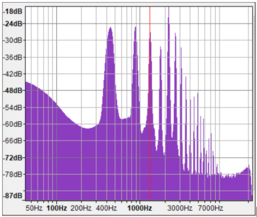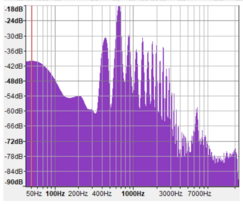Course:PHYS341/2022/Project12

Electric Violin
Background

The first violin dates back to the early 16th century, and various versions of the instrument were involved in the classical violin we know today[1]. Many evolutions represented happy Renaissance fiddles, most famously played on stringed instruments[2]. Like the traditional violin, the electric violin is also within the same category as a string instrument. It is also tuned to the notes E5, A4, D4, G3 but are often adjusted and changed on the electric violin.
The violin is propped onto the left shoulder and clamped down with the chin. The right hand holds the bow, while the left-hand plays the violin. Unlike other string instruments like the guitar, there are no frets or markings to help indicate where notes are. Therefore the difficulty to play the violin is a lot higher since players have to learn the exact placement of their fingers on the left hand and build muscle memory.
History
The electric violin has been around only since the early 20th century, compared to the traditional violin has been around for centuries. The electric violin became an enjoyable combination alongside the electric bass. It is in various genres like jazz, rock, and sometimes blues, or in some scenarios, even folk music[3].
Electric violins only follow a similar outline and shape to a traditional violin and come in many colours and shapes shown in Figure 1.
Structure
Despite the invention of the electric violin, acoustic violins could imitate them too. A device called the electrodynamic pickup goes underneath the fingerboard of an acoustic violin, which will avoid interference with the part of the violin that produces sound, conserving the resonance and tone intact[4].
The solid-body helps avoid feedback from the resonance. The considerable resonance gives timbre to the traditional violin. Compared to the acoustic violin, on the electric violin, we may hear two new sounds, "raw" and "sharp." The solid body of an electric violin is partially why the electrical violin does not have the identical stylistic conventions as an acoustic violin; the weight is noticeably heavier. The minimalistic look takes away the traditional look of a violin but gives it an interesting modern twist. Commonly used materials such as kevlar, glass and carbon fibres make the electric violin.
Surprisingly, the electric violin has been very experimental and is "less established" than the electric guitar and bass. Against the standard design, there are many alternatives, most familiarly, extra strings. Luthier Yuri Landman is a musician who built an electric violin consisting of 12-strings for the Belgian band DAAU. The solid body of the electric violin benefits from this new style because it can accommodate the extra tension from the additional strings. Acoustic violins also have similar cases, where 5-string violins are slowly becoming popular (Figure 3).

Pickups
On electric violins, pickups are magnetic, electrodynamic, or piezoelectric. Electrodynamics includes a current or voltage constructed in a conductor by a changing magnetic flux. Piezoelectricity includes materials such as ceramics and quartz crystals, when the material has pressure, the atoms slightly rearrange, resulting in a charge on the opposite areas of the material. All that is needed is a couple of single-coil magnetic systems, and the arced string arrangement and small body size of the violin limit the space for placing the coil. Because it is for acoustic violins, the string is electrically conducting, so strings like steel core are appropriately used.
In general, piezoelectric pickups are standard and are a more inexpensive option. The piezoelectric pickups directly pick up vibrations and are placed on the violin's body, on the string itself or familiarly, placed on the bridge of an acoustic violin (Figure 2)[5]. On the electric violin, the vibration from the bowing transfers onto the wooden body of the violin, where the piezo microphone picks up the signal and converts it into an electric signal.
Amplification
If you are familiar with the amplification on a guitar, the amplification on a violin works the same way. For both instruments, the production of the audio output transfers through an audio cable into a Public Address (PA) or an amp. Fortunately, you can not use the same amps made for a guitar on a violin, but there are also specific amplifiers for the violin. Guitar amps are more advantageous is because they have been modified over the years and making them more of a reliable source, though they may not achieve the desired tone. Tube amps have a mellow tone, but for violins, usually, the solid-state amps and digital PA's are preferred.
Instead of using a chord, there have been considerations for a Bluetooth option. Unfortunately, compared to using amps, it is unreliable because of its occasional dropouts and long re-connection times.
Sound Measurements and Timbre
The first harmonic, also known as the Fundamental Frequency is what determines the pitch of the note. In the following examples, the pitch is an A4, at approximately 440Hz. The overtones, which are the frequencies at the second, third, fourth, and more harmonics, give the tone a complex sound. The overtones are not heard as separate notes, although we do hear a mixture of them, and represent the instrument’s timbre. The spectrum analysis shows what was expected in all three instruments, each peak has a equal amount increase of 2, 3, 4, and 5 times the first peak. Despite this, looking at Graphs 1-3 shows that the timbre of the instruments vary. Different amounts of each frequency gives the instruments their unique sounds.
Comparison of Timbres
The comparison will be made on the Acoustic Violin (Graph 1), Electric Violin (Graph 2) and Electric Guitar (Graph 3). In these three instruments the Graph 1-3 show each instrument playing the same note, the A4; a commonly used note to tune to especially in orchestras. The Spectrum analysis is shown in Tables 1-3.
Prediction
The predicition is that the timbres of the electric violin to be an average of the timbres of the acoustic and electric guitar. The reason being, the electric violin has a bow like the acoustic violin, which is how the sound is produced, but the amplified sound is more similar to that of a electric guitar.
Results
The highest frequency on the acoustic violin and electric violin is the same, and they are both on the fourth fundamental at approximately 1784 Hz. This similarity may be because both instruments use a bow, and perhaps the bow brings out the fourth harmonic, giving stringed instruments of this kind their unique timbre. In contrast, the electric guitar has the highest frequency on the second fundamental at approximately 882 Hz. A slightly closer look at the acoustic violin again, the first and second fundamental is very similar heights. But on the electric violin, the second fundamental is scarcely higher than the first.
To conclude, it is interesting to see some aspects of both the acoustic violin and electric guitar within the spectrum for the electric violin. But unlike our prediction, it is not exactly the average of the two instruments and instead is more like a slight alikeness.

| Peak # | Frequency | Comparison to Frequency in First Peak |
|---|---|---|
| 1 | 444 Hz | ------ |
| 2 | 883 Hz | ≈1.98 times the first peak |
| 3 | 1324 Hz | ≈2.98 times the first peak |
| 4 | 1774 Hz | ≈3.99 times the first peak |
| 5 | 22137 Hz | ≈4.92 times the first peak |

| Peak # | Frequency | Comparison to Frequency in First Peak |
|---|---|---|
| 1 | 436 Hz | ------ |
| 2 | 876 Hz | ≈2.00 times the first peak |
| 3 | 1312 Hz | ≈3.00 times the first peak |
| 4 | 1794 Hz | ≈4.11 times the first peak |
| 5 | 2187 Hz | ≈5.01 times the first peak |

| Peak # | Frequency | Comparison to Frequency in First Peak |
|---|---|---|
| 1 | 443 Hz | ------ |
| 2 | 882 Hz | ≈1.99 times the first peak |
| 3 | 1320 Hz | ≈2.97 times the first peak |
| 4 | 1767 Hz | ≈3.98 times the first peak |
| 5 | 2200 Hz | ≈4.97 times the first peak |
References
- ↑ Boyden, David D. (1989). Violin family. London: Macmillan. pp. 46–49. ISBN 0333444515.
- ↑ Beisswenger, Drew (2011). North American fiddle music: a research and information guide. Florence: Taylor & Francis Group. pp. xiv–xxiv.
- ↑ Levesque, Roger (2012). "14th Blues Festival lineup announced; Fresh talent includes electric violin whiz Lionel Young". https://www.proquest.com/newspapers/14th-blues-festival-lineup-announced-fresh-talent/docview/1010078216/se-2?accountid=14656 – via ProQuest. External link in
|journal=(help) - ↑ Gunther, Leon (2012). The Physics of Music and Color. New York, NY: Springer. pp. 11–62, 127–178. ISBN 1-4614-0556-4, 978-1-4614-0556-6 Check
|isbn=value: invalid character (help). - ↑ Ştefănescu, Dan Mihai; Dan Mihai, Mirela Adelaida (February 2013). "Electrical methods for force measurement – A brief survey". Romanian Measurement Society. 46: 949–959 – via ELSEVIER.